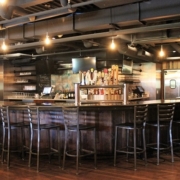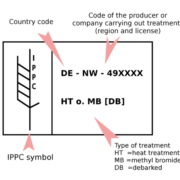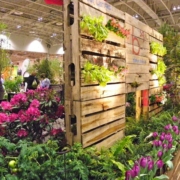Upcycled Wood Pallets: The Forklift & Palate Restaurant
The Forklift & Palate Restaurant
If the walls of the Forklift & Palate Restaurant could talk, they would tell a tale of American enterprise and vision comingled with respect and care for the environment.

Upcycled wooden pallets at the center of attention in The Forklift & Palate Restaurant. Photography © Stephanie Jordan
The Forklift & Palate Restaurant is housed along with The Warehouse Hotel and Spooky Nook Sports facility in a repurposed industrial warehouse in Manheim, PA. Located in the heart of the famed Pennsylvania Dutch country, the restaurant offers authentic down-home American hospitality, new twists on classic American culinary favorites, and surroundings that incorporate imaginative uses of the building’s original industrial trappings, including pallets, pallet slats and cable spools. Yes, we’re talking about pallets, wooden shipping skids that were stashed onsite when the former Armstrong World Industries distribution center was purchased and converted into a world-class sports training and entertainment center in 2011.
The Forklift & Palate Restaurant features recycled and repurposed materials from the original warehouse throughout the facility, right down to the cement in the driveway and the pallets that frame display murals on the walls. Tables in the restaurant and bar area made from used pallet slats sit adjacent to tables made from large circular wire spools lending a casual, rustic ambiance to the space. Every wall in the restaurant is unique; many are faced with pallet slats and other recycled materials. Even the menu holster at the hostess station is made from used pallet slats.
“Everybody loves the décor. It’s very natural, very authentic. And it’s a comfortable setting where people can relax and chill with friends, buddies and teammates,” said Tim Brandt, Forklift & Palate Restaurant manager. “The place has a great vibe and people feel really good about the green theme of reusing, recycling, being earth friendly. Of course, they love the great food and friendly service, too.”
The restaurant’s environmental ethos goes well beyond its contemporary industrial décor stylings to incorporate state-of-the-art environmental systems such as geothermal heating and rainwater recycling. “With all of our three entities, we are committed to environmentally friendly practices, from the types of cleaners we use to the conservation of water in our restrooms, turf watering practices and kitchens,” said Stephanie Jordan, Spooky Nook’s marketing manager. “By using repurposed building materials in our complex, restaurant and hotel, we hope to preserve not only beautiful Lancaster County, but also the history of this unique building.”
The Forklift & Palate Restaurant opened and began welcoming guests over the 2015 Independence Day weekend. The Spooky Nook complex, which sits on 65 acres and owes its name to its location on Spooky Nook Road, is the nation’s largest total experience sports destination. The Nook hosts tournaments, leagues, camps and clinics in sports ranging from baseball, basketball, football and ice hockey to fencing, tennis, soccer and scores of other sports activities.
(Article written for and published in PalletCentral, September-October 2015)












